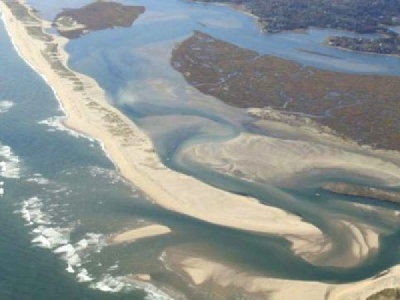
Posted on September 24, 2018
For some, the town’s ship of state is hung up on a sandbar, unable to sail through the planning and permitting necessary to dredge the Nauset Estuary and allow commercial and pleasure craft to navigate more easily between Town Cove and Nauset Inlet.
“There IS an emergency in Nauset Marsh,” Charles Carlson wrote to selectmen Kevin Galligan and Mefford Runyon Sept. 3. “Yet, to the best of my knowledge, the town has not made a serious attempt to obtain emergency dredging authority and emergency permission to use the dredged material on portions of the outer beach north of the town beach.”
Similar concerns prompted a summit of sorts at the selectmen’s Sept. 12 meeting, which was attended by Leslie Fields, the town’s dredging consultant from Woods Hole Group, and local fishermen, boats, and marina owners. Concerns and explanations were exchanged, and it appeared that an all-hands workshop at a special Saturday meeting was needed to focus the effort.
“What our (commercial fishermen) are saying here is that the whole channel system is essentially shut down,” said Selectman Mark Mathison. “If a hurricane takes a right-hand turn and heads this way, and those guys want to get their boats to Mill Pond, they can’t do it.” Later, citing concerns by marina owners about recreational boaters going elsewhere to launch, he said, “If two of the biggest businesses in this town can no longer function because there’s no viable waterway, that’s an economic disaster that’s unfathomable to the town of Orleans.”
With town plans in progress calling for dredging in 2022, Mathison said, “That’s not acceptable. We can’t wait four years for something to happen down there.” Then he proposed a special Saturday meeting with his board, Eastham’s selectmen, the Woods Hole Group, the National Park Service, fishermen, and the relevant town committees “to sit down and prioritize what needs to get done…to bring relief to all those people who depend so much on this estuary.”
Fields led off last week’s meeting with an extensive look at just what the town has been doing to advance dredging projects, after Selectmen Chairman Alan McClennen noted that the last town dredging project in the estuary was completed in the 1920s. Town meetings in 2015 and 2016 appropriated funds for the current project.
“There’s been continued shoaling in that channel behind the barrier beach,” Fields said. “There’s still a very real need to get this project done.” After a feasibility study was completed, she said, the Cape Cod National Seashore wanted a further look at potential eelgrass beds, which was done. Woods Hole Group also did sediment studies to determine which dredged material would be appropriate for various locations. After consultation with local shellfishermen, the proposed dredge channel was altered to avoid significant impacts to those resources.
Fields said the first phase of the project, basically the inner part of the channel, does not have to go through federal review and could be accelerated. The rest of the channel will require full National Environmental Policy Act review, as well as state and Cape Cod Commission scrutiny, among others. She said the Seashore “really didn’t have a problem with dredging so long as it’s for improved navigation and public safety, but they do have concerns over temporary dewatering of (dredge spoils) on the barrier beach…and concerns about using dredge materials on Nauset Beach (regarding) the spread of red tide cysts in Pleasant Bay.”
Red tide researchers at Wood Hole Oceanographic Institution, who’ve been studying the phenomenon for decades, advised doing a pilot project on the mortality of red tide cysts in dredged material. “They feel that once those cysts are put into a sort of dune that dries out that they will dessicate and die,” Fields said. “We need to prove it to the Cape Cod National Seashore before we pump it down to Nauset Beach.”
The selectmen authorized Fields to proceed immediately with obtaining permits and starting the red tide study, and she promised results by February.
“I want to make sure when we start doing this research project where we dump sand on the beach and let it dry out, we are not going to wait another 90 days or six months” before we hear from the Seashore, Mathison said. “This needs to be done right now. We expect because of the emergency situation in the estuary, when winter is over and all those things are dead, (the Seashore) will say go ahead, not send us that data and we’ll get back to you.” Seashore Superintendent Brian Carlstrom was invited to last week’s meeting but could not attend.
“I don’t want to get into a fight with the National Park Service that goes on three years while we sit out in a very precarious position,” commercial fisherman Steve Smith said during the meeting. “I’d rather have them see us as cooperating. Just go along with one area that has sand without the red tide, and work on the the rest of the project over the next four years.”
Before Smith spoke, Fields said the current timeline for permits would be the end of 2021, with dredging in the winters of 2021-22 or 2022-23.
“This schedule does not work,” Galligan said. “I don’t like the start in 2022. The dynamics out there are not productive economically, not even for the environment. Is there any way of accelerating (this)?” Fields said she would ask regulatory agencies about emergency dredging in certain areas.
Referencing the proposed Saturday summit meeting, McClennen said the town would get all parties together “and have a day. We might even provide a lunch.” “The shellfishermen are going to bring littlenecks,” Mathison said. “And,” McClennen added, “we’ll issue a beer and wine license.”
Source: The Cape Cod Chronicle





